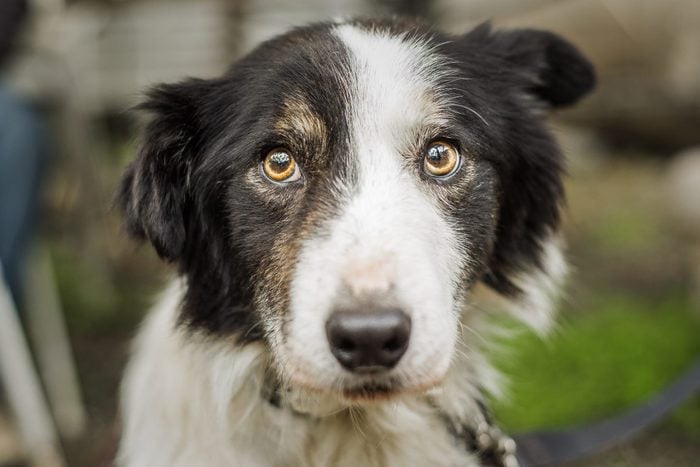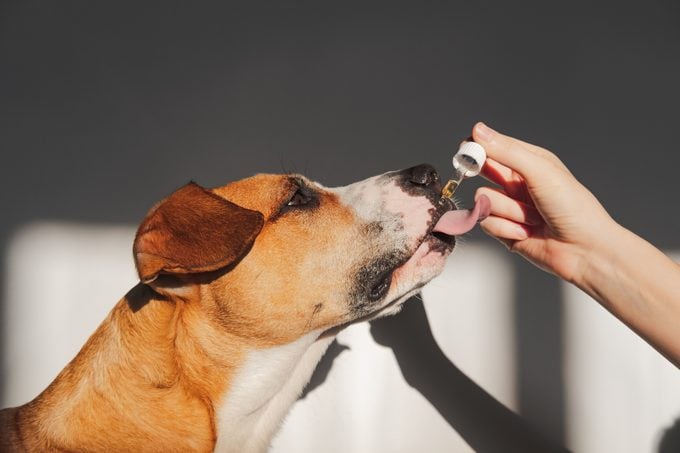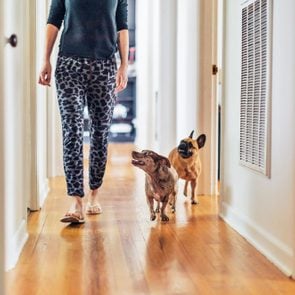Dog Anxiety: 7 Reasons Your Dog May Be Stressed—and What to Do About It
Updated: Apr. 01, 2024

When your cherished pup is anxious, all you want to do is assure it everything will be OK. Here's what you should know about dog anxiety and how you can help your furry friend feel better.
Our editors and experts handpick every product we feature. We may earn a commission from your purchases.
Some types of dog anxiety are fairly easy to understand: When your dog cowers under the table during a thunderstorm, you know it’s not crazy about loud noises. Other reactions aren’t so easy to figure out. After all, dogs can’t exactly verbalize what is going on when they are stressed. That leaves pet parents with plenty of questions about dog behavior. Do dogs cry when you leave them alone? Is it possible for them to have dog depression? We spoke to top veterinarians and asked them to explain why our precious pups get stressed—and what we can do to help.
Top reasons why dogs get anxiety
Dogs are social animals that are highly dependent on their group. In the wild, they’re dependent on members of the pack. In domestic bliss, it’s humans.
“The reasons for anxiety are often linked to this attachment to the group; dogs are very sensitive to the cohesion of the group,” says Jean-Pierre Lautier, DVM, deputy CEO and pharmaceutical manager at pet care company Alzoo. “It is very unusual and very distressing for a dog to be separated from its group.” This is why many dogs experience separation anxiety when they are home alone. (By the way, this is how long you can leave a dog alone at home.)
Yet dogs can get stressed for a number of reasons—some of which are very relatable to the anxieties we might have, like meeting new people or a fear of loud thunderstorms. “Dogs can get anxiety, and it can take many forms. What makes one dog anxious can be almost as unique as the dog itself,” says Chaundra Schofield, VMD, a veterinarian with IndeVets.
Here are the top reasons why dogs get stressed:
- Separation anxiety
- Noise phobias
- Isolation anxiety
- Social anxiety
- Confinement anxiety
- New experiences
- Generalized anxiety
What’s the difference between separation anxiety and isolation anxiety?

Most of the above anxieties are self-explanatory, but the line between separation and isolation anxiety is a little murkier. They’re easily confused because both types of dog anxiety can occur when a dog is alone. “In isolation distress, the anxiety is not focused on a particular relationship but simply the fact that they are alone,” explains veterinarian Kelly Dunham, DVM, of IndeVets. “In these cases, any warm body will do to relieve the stress.”
Separation anxiety occurs when a dog is separated from its human. Its stress often manifests in destructive behavior, such as going potty indoors, and might be one of the reasons your dog howls or barks too much.
Obvious signs your dog is dealing with anxiety
If your dog hides under the coffee table during a thunderstorm or pees inside the house when someone it doesn’t know visits, you can deduce that it’s probably due to anxiety. The behaviors below are all signs your dog may be anxious:
- Avoidance
- Panting
- Pacing
- Whining and crying
- Trembling and shaking
- Inability to settle down or frequent changes in position
- Excessive drooling
- Excessive licking
- Eliminating inside the house
- Destructive behaviors
- Not eating
Subtle signs your dog has anxiety
“Some of the most common signs of anxiety in a dog do get missed by owners, often because they are very subtle,” says Jamie Freyer, DVM, an expert with Veterinarians.org. The subtle signs may point to mild anxiety or a precursor to full-blown anxiety:
- Licking the lips
- Yawning
- Tucking in the tail
- Pulling the ears back
- Showing the whites of the eyes
What dog breeds have the most anxiety?
Before we get into the specific breeds that tend to experience the most dog anxiety, know that all dogs are individuals, and any dog can get stressed out from time to time. Think about all the dogs adopted during the pandemic who spent most of the entire day at home with their pet parent. “Although research will likely lag behind the pandemic, in our experiences, pandemic puppies who have never been alone and improperly socialized dogs have higher levels of certain types of anxiety,” says Marisa Brunetti, VMD, the chief medical officer of IndeVets.
Still, some breeds are more disposed to anxieties particularly, social anxieties. Even if they are purely companions today, some of the most popular dog breeds were bred with a specific purpose in mind and can get anxious if they don’t punch in for work. For example, border collies herd sheep, German shepherds and rottweilers are guard dogs, and the Jack Russell terrier is widely known as being the best ratter. Each breed may get anxious if they aren’t doing what their instincts tell them to do.
On the other hand, dogs that are actively working closely with their humans are much more sensitive to separation, Dr. Lautier says. Hunting breeds require constant interaction with their humans, and they tend to be very affectionate and clingy. “They will be much more sensitive to separation,” he explains. That said, they are tolerant and patient and make great dogs for kids and families.
How can I help my dog with anxiety?

In an ideal world, the first option would be to remove the source of anxiety, but that’s not always possible. For instance, if your dog has a fear of men in hats, it might see someone on a walk, and its stress level may spike. “While the underlying feeling may be the same, every type of anxiety has its own recommended treatment,” Dr. Freyer says. If you think your dog has signs of anxiety, you should discuss this with your veterinarian. Dog anxiety is typically addressed with a combination of calming products, behavior modification, natural supplements, or medication.
Natural supplements
Depending on the pet’s history, Dr. Brunetti’s treatment plan typically includes calming supplements such as Composure Pro, Solliquin, Zylkene, Purina Pro Plan Calming Care, and pheromones. “The Adaptil pheromone is a synthetic analog to the calming pheromone that a mother dog gives off to her puppies,” says Dr. Brunetti. Her favorite choice is the Adaptil plug-in room diffuser, but it’s also available in a spray or collar.
For more ways to calm an anxious dog without medication, Dr. Lautier, who specializes in pet behavior problems, suggests trying natural substances known for their anxiolytic properties (like the medicines that treat anxiety). “These substances work in the brain by slowing down the breakdown of soothing neurotransmitters,” says Dr. Lautier.
Consider trying either a calming plug-in diffuser, anti-stress collar, or calming spray. If you don’t see positive results with one product, try another. “Some pets react better to a collar versus a spray or a diffuser versus a collar,” he says. “It is important to observe your pet closely to see which has the most calming effect, as each pet and situation are different.”
CBD dog treats for anxiety
There is a lot of hype and hope surrounding CBD, including CBD treats for dogs. Cannabidiol, also known as CBD, comes from the hemp plant, a cousin of marijuana, but it doesn’t produce the “high” associated with marijuana. Some pet parents say CBD helped their dogs manage anxiety better than antidepressants. But more research needs to be done on safety and efficacy.
It is the position of the American Association of Veterinary State Boards for veterinarians to be able to talk to their patients about CBD. Still, not all states allow this. It’s important that you tell your vet if you plan on using a product with CBD. If your vet can’t assist you, they may recommend a veterinary cannabis counselor. If you decide to purchase a CBD pet product, be sure to look for the certificate of analysis.
Behavioral modification
It can be frustrating and challenging to deal with an anxious dog who is being destructive or going potty inside the house, but punishment (aka negative reinforcement) is never appropriate and can actually make the behavior worse, Dr. Brunetti says. Behavioral modification, on the other hand, sets your dog up for success. In a nutshell, behavioral modification involves an integrated approach that uses techniques to help decrease the frequency and expression of anxiety behaviors.
“Behavioral modifications like the Thunder Shirt [or similar swaddling product], along with providing a quiet, calm place with music, such as Through a Dog’s Ear [available on Spotify or CD] or white noise can also be beneficial,” says Dr. Brunetti. Behavioral modifications don’t always require special equipment.
In counterconditioning, your pup learns to become happy and accept fearful things—say, the vacuum cleaner or noisy icemaker. In this technique, gradual exposure is paired with something the animal likes, like a desired treat. In time, your pup will associate the fearful noise with something positive.
Medication
“When supplements and behavioral modifications are not easing dog anxiety, there are situational medications for dogs that can be used as needed, or there is daily medication like Prozac that can be given long-term while training and supplementation are continued,” Dr. Brunetti says.
But you won’t be using medication as the sole treatment. Your veterinarian may recommend a veterinary behavioral specialist to help with training and behavior modification when using anxiety medication for dogs. “Even if your dog is given medication for their anxiety, medications work best when paired with a specific behavior treatment. Therefore, your chances of seeing your dog improve increase dramatically when behavior modification is included in your treatment plan,” says Dr. Freyer.
Treatments for dog anxiety are as individual as dogs themselves. If you’re concerned about your pet’s level of anxiety, your vet should always be your first call.
Sources:
- Jean-Pierre Lautier, DVM, deputy CEO and pharmaceutical manager at Alzoo
- Chaundra Schofield, VMD, veterinarian at IndeVets
- Kelly Dunham, DVM, veterinarian at IndeVets
- Jamie Freyer, DVM, expert with Veterinarians.org
- Marisa Brunetti, VMD, chief medical officer of IndeVets



